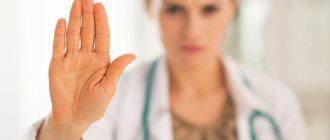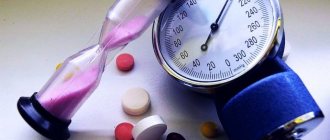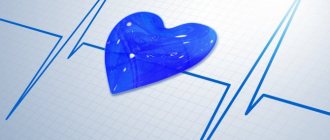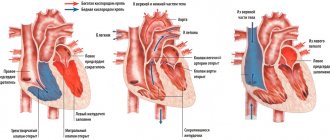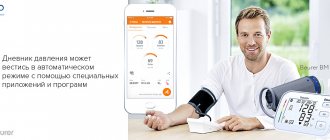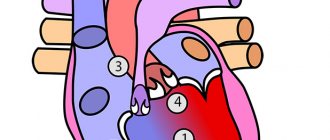© Author: Sazykina Oksana Yuryevna, cardiologist, especially for SosudInfo.ru (about the authors)
Doctors teach many patients with attacks of paroxysmal tachycardia to independently perform so-called vagal tests. These are the simplest manipulations aimed at a reflex effect on the cardiovascular system. This includes the Aschner test with pressure on the eyeballs, the test with straining and coughing, and massage of the carotid sinus. Each of these manipulations is based on mechanical stimulation of receptors associated with the neurohumoral regulation of the heart muscle. This irritation leads to a decrease in heart rate, which in the case of palpitations plays a positive role in restoring normal heart rhythm. But some may develop adverse consequences due to such tests, so such tests are currently contraindicated for the patient to perform independently without medical supervision. In particular, we are talking about massage of the carotid sinus.
Anatomical and physiological features
The sinocarotid zone is a small formation at the site of the branch of the internal carotid artery from the common carotid artery, in the inner membrane of which there is a high density of baroreceptors. The carotid sinus itself is located in the inner lining of the artery (in the intima).
These receptors are represented by protein complexes that detect fluctuations in blood pressure in the vascular bed. From the receptors, electrical impulses are transmitted along the nerve fibers of the vagus nerve to the brain, and then, through the centers of the autonomic nervous system, an inhibitory effect is exerted on the sinus node, located deep in the myocardium of the right atrium. Thus, the heart muscle contracts less frequently, cardiac output becomes less, resulting in a decrease in overall peripheral vascular resistance.
Elderly patients suffering from atherosclerosis of the carotid arteries must remember that the slightest mechanical irritation of the neck area (tight collar, scarf, strong tilting of the head back) can have an irritating effect specifically on the sinocarotid zone, which, in the presence of hypersensitivity of the carotid sinus, can cause hemodynamically significant a decrease in heart rate and a decrease in blood pressure below critical.
Execution Rules
The carotid sinus is convex, so it is not difficult to find it with your fingers on either side of the Adam's apple.
The carotid sinus is located in the neck between the outer and inner sides of the carotid artery. It is convex and can be felt by hand. This will require some experience and knowledge of diagnostic techniques. The essence of the procedure is that the doctor moves his fingers to the location of the Adam's apple under the larynx and raises the palm higher.
Do not put pressure on the carotid artery when searching for the point of influence. Even short-term compression of a large blood vessel can negatively affect the patient’s health.
Pressure on the area of the carotid sinus excites the vagus nerve. With its help, the interaction of organs and tissues of the neck, head, chest and abdominal cavity occurs. This ensures electrical stimulation and communication with the central nervous system.
Carotid sinus massage technique
During the massage, 5-10 presses are performed for 10 seconds each.
Stimulation of the carotid sinus baroreceptors is performed in a medical facility by an experienced specialist in full compliance with the rules. During the massage for diagnostic purposes, the patient is in a supine position. As a rule, a table is used for this.
It is important that the patient does not feel fear or anxiety. Before proceeding directly to the massage, the patient is allowed to rest for at least five minutes to relax and allow the body to get used to the change in position. At the same time, the heart muscle returns to its usual rhythm of work.
The person being diagnosed is connected to an electrocardiograph and recording begins. Blood pressure monitoring is also carried out; for this purpose, a tonometer cuff is put on, which records and displays measurement data on the monitor.
The procedure is done manually. The doctor's thumb rests on the patient's neck. First, massage the right side. If the desired result is not achieved, the left side of the carotid artery is affected.
The desired effect is obtained through short-term pressure on the carotid sinus. One exposure lasts less than 10 seconds. The breaks between approaches are one minute. As a rule, do 5-10 presses.
Indications for carotid sinus massage
Previously, this procedure could be recommended by a doctor to a patient as a treatment procedure during an attack of tachycardia. But, due to the fact that massage can neutralize an attack exclusively of sinus or supraventricular tachycardia, and is ineffective for other types of tachyarrhythmias (atrial fibrillation, ventricular tachycardia), and the patient is not able to independently interpret this or that type of rhythm disturbance, then perform this procedure not only pointless, but also dangerous. It is dangerous precisely because excessive stimulation of the sinocarotid zone and irritation of the carotid sinus can provoke a sharp decrease in pressure, up to a syncope with loss of consciousness.
Currently, massage of the sinocarotid zone is performed only under medical supervision, with a cardiogram recorded and blood pressure measured. This manipulation is used exclusively for diagnostic purposes, if the presence of carotid syndrome is suspected.
Indications for CS massage
Massage of the carotid artery can prevent fainting, improves blood flow.
Massage of the carotid artery is a diagnostic procedure that is used to make diagnoses in cases of disruption of the central nervous system.
Research has shown that carotid sinus massage:
- relieves an attack of dizziness and reduces the number of fainting spells of unknown etiology;
- helps dilate blood vessels, improve blood flow, normalize blood pressure and reduce stress on the heart.
- stops an attack of paroxysmal tachycardia, reducing the load on the heart muscle.
The main indication for carotid sinus massage is the need to confirm/refute the diagnosis of “carotid sinus syndrome”.
The procedure is carried out in a specialized medical facility by an experienced specialist under continuous monitoring with recording of an electrocardiogram and blood pressure.
How does carotid syndrome occur and why is it dangerous?
This syndrome occurs in elderly patients due to the lack of elasticity of blood vessels affected by atherosclerotic plaques in the area of the branching of the carotid arteries. An increased sensitivity of baroreceptors is formed in the sinocarotid zone, from where inhibitory signals arrive to the conduction system of the heart. As a result, the heart rate decreases, and as a result, cardiac output decreases. Since these processes lead to a decrease in blood supply to the brain, the patient loses consciousness (usually lasting no more than one minute). Such attacks can be repeated quite often.
Treatment options
The conservative technique consists of prescribing:
- Maintaining a correct lifestyle - preventing sudden head movements, wearing comfortable clothes that will not put pressure on the cervical spine, undergoing training to identify the symptoms of the anomaly.
- It is recommended to consume large amounts of liquid (up to two liters) and salt (up to six grams).
- Taking pharmacological substances according to the prescription of the attending physician.
Technique for carotid sinus massage
A doctor can perform massage of the sinocarotid area. The test is carried out as follows. The patient is in a supine position, with a tonometer cuff on the shoulder, and with the electrodes of the ECG machine applied.
The doctor stands at the head of the patient, feels a small rounded formation on the neck behind the angle of the lower jaw on the right (in some cases, bilateral stimulation is required), and then stimulates the sinocarotid zone with circular movements for 3-5 minutes.
After a short stimulation of the sinocarotid zone, the patient's blood pressure is measured and an electrocardiogram is recorded. Even if loss of consciousness does not occur, but the patient experiences an episode of bradycardia lasting more than three seconds, or there is a sharp decrease in blood pressure by more than 50 mm Hg, the result is regarded as positive.
Carrying out procedures for heart diseases
In case of IHD (coronary heart disease), massaging of the carotid sinus is performed when an attack occurs. It is recommended to carry out the procedure immediately. The patient is placed on his back, the neck is straightened and gentle pressing movements are made. Massaging is carried out once, the doctor adjusts the duration and frequency of pressing depending on the improvement or deterioration of the patient’s condition.
Massage for vegetative-vascular dystonia is the most frequently prescribed procedure, because... VSD requires long-term treatment, and massage is the optimal means of therapy, less toxic compared to drug treatment. Massage for VSD helps relieve rapid heartbeat and headaches. This improves the patient’s condition and relieves the uncomfortable symptoms of VSD. In this case, the doctor prescribes 3 procedures lasting 6-8 minutes.
Massage for arrhythmia is prescribed with caution, because... the procedure slows down the heart, which helps eliminate the threat of cardiac arrhythmia, but can provoke ventricular arrhythmia in older patients. During its implementation, the doctor monitors the patient especially closely and adjusts the duration of the massage and pressure. To improve heart function, 3-4 procedures lasting no more than 10 minutes are performed.
Massage for angina pectoris is intensively performed alternately on the right and left sides to achieve a quick effect when attacks occur or when testing the patient’s condition. But there are contraindications that the doctor must pay attention to: hypertension and thromboembolic complications. The procedure is carried out 2-3 times lasting from 5 to 10 minutes. The technique is adjusted, the time of exposure to the sinus changes depending on the pathology.
Contraindications for carotid sinus massage
This manipulation is strictly contraindicated if the patient has such unfavorable symptoms as:
- Severe shortness of breath, especially worse when lying down (a sign of congestion in the pulmonary vessels),
- A suddenly developed cough, dry in nature or with sputum, especially foamy pink ones (may be a sign of acute left ventricular failure).
- Intense pain or even mild pressing discomfort in the chest (a symptom of probable acute coronary pathology and pre-infarction condition),
- Very frequent pulse (more than 150 per minute), especially in combination with loss of consciousness, since such rhythm disturbances are accompanied by disturbances in intracardiac and general hemodynamics.
Carotid sinus massage is strictly contraindicated for diseases such as:
- acute and exacerbation of chronic heart diseases (heart attack, chronic heart failure, heart rhythm disturbances),
- exacerbation and decompensation of other chronic diseases (bronchial asthma, diabetes mellitus),
- acute infections,
- general poor health of the patient,
- low blood pressure and low pulse.
So, massage of the carotid sinus is not only a therapeutic, but also a diagnostic procedure that allows one to differentiate the nature of fainting, especially in older age. If we talk about massage as a therapeutic procedure, then patients need to clearly understand that it is unacceptable to perform massage in this area on their own.
How does SCS manifest itself?
The symptoms of the disease are presented in a wide range, but its characteristic nuance is the relationship of the problem with irritation of the danger zone. Fainting is a common symptom of SCS. In the case when reactions of a prodromal nature occur before it, patients are able to foresee the impending condition in advance. During presyncope, patients report:
- The occurrence of shortness of breath.
- The appearance of dizziness.
- Panic attacks caused by fear.
However, in older people, symptoms are minimal or completely absent. Loss of consciousness lasts for 10-60 seconds, but sometimes fainting does not occur. Patients who stand may fall. Fainting causes changes in skin color (pallor), increased levels of sweat, slow heart rate and hypotension. An abnormal reaction over a longer period provokes muscle cramps and uncontrolled urination.
During recovery, patients experience mild amnesia and body weakness. Additional symptoms are:
- Unstable functioning of the speech apparatus.
- Involuntary flow of tears.
- Loss of normal muscle tone.
Cognitive disorders have been observed in older people.
Likely consequences
More than 50% of patients who have ever experienced fainting due to SCS report severe bodily injury. The likelihood of a negative phenomenon increases for pensioners, at a time when loss of consciousness occurs abruptly and without warning. In 25% of cases, doctors diagnose hip fractures. There are bleeding inside the skull and injuries to internal objects that require emergency medical care.
Diagnostic methods
Often, the disease manifests itself without previous symptoms, and as a result, collecting information from the patient may not give a positive result. The main technique that gives an accurate idea of the deviation is massage of the carotid sinus. Clinical technology prescribes it to all patients with loss of consciousness without reason. The procedure is performed in a certain position (lying on your back) with connected sensors to monitor ECG and pressure. A positive response is obtained when asystole appears for more than three seconds, a decrease in blood pressure above 50 millimeters of mercury, or a combination of both.
